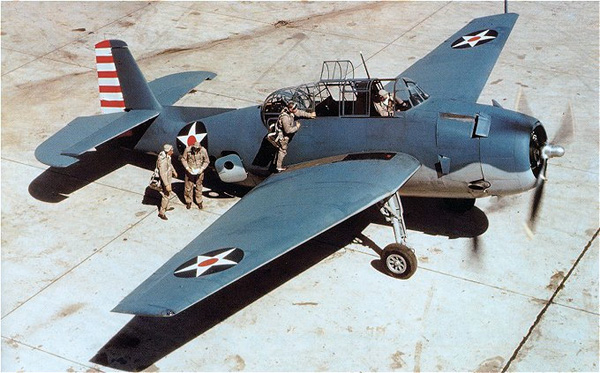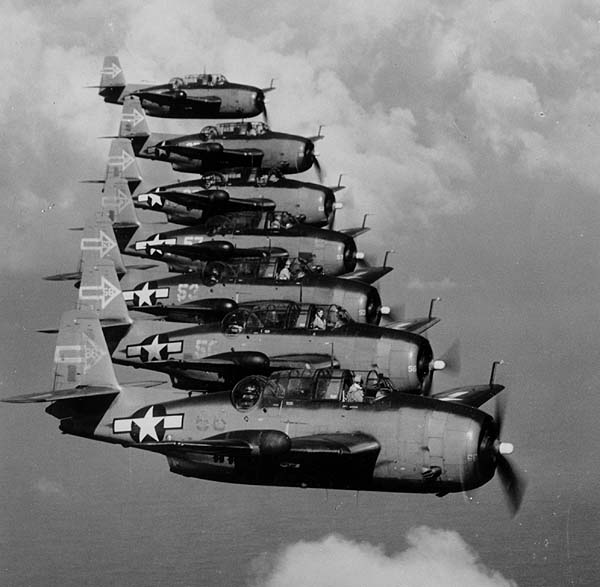
|
 |
Grumman TBF Avenger |
 |
 |
 |
 |
 |
|---|---|---|---|---|---|---|---|
 |
 |
 |
 |
 |
|||
 |
||
| Despite being the heaviest single-engine aircraft in World War II, the Grumman Avenger would provide stellar military and commercial service for more than forty years. It was built to replace the TBD Devastator which became obsolete after being in service for only two years. However, the Avenger still took a beating in its combat debut.—five out of six Avengers were lost five at the Battle of Midway. Badly shot up, the remaining Avenger's gunner was killed and its radioman and pilot wounded. Despite its inauspicious beginning, it would redeem itself and provided stellar service until the end of the war and beyond. | ||
| It was designed in only five weeks and with its square-tipped wings and fuselage shape, it looked like a scaled-up version of the F4F Wildcat. It also featured a famous Grumman trademark, the compound-angle "Sto-Wing" that was developed on the F4F-4 Wildcat.1 Although among some pilots, its ungainly appearance earned it the nickname Turkey. |
| As part of a competition in 1939 among thirteen designs, (submitted by Brewster, Douglas, Grumman, Hall, Vought and Vultee) the US Navy would order one Vought XTBU-1 and two XTBF-1 Grumman prototypes. One Grumman prototype featured a two-speed engine, while the other featured a high-altitude two-stage engine. Orders for the prototypes were placed with Grumman on April 8, 1940 and from Vought a few weeks later. This would become Grumman’s introduction into the realm of carrier-based torpedo bombers. The Vought design would become the TBY Sea Wolf, but only 180 aircraft would be built. |
|
The inaugural flight of the XTBF-1 was on August 1, 1941 with chief engineer Bob Hall at the controls. The first three flights totaled less than three hours, exposing various design faults. The most serious being the engine, which was located too far aft, requiring it to be moved forward to properly relocate the c.g. Other modifications included, improved engine cooling, and enlarging the tail surfaces. The aircraft also had a slight lateral instability, but this was corrected in the second prototype with the addition of a dorsal fin above the fuselage.2
The design team was led by William T. Schwendler and although the airplane slightly resembled the Wildcat, it was substantially larger with a deeper belly. The wings were center-mounted that folded alongside the fuselage. Leading edge slots forward of the ailerons and trailing-edge split-flaps provided good low-speed handling characteristics. The internal bomb bay was located below the wing with doors that were hydraulically controlled. It was large enough to house a 22 inch (60 cm) Mark XIII torpedo or four 500 lb (225 kg) bombs. A crew of three sat in line beneath a large canopy that included a pilot, bombardier and rear gunner. A Norden bombsight was provided but this was removed later as being too impractical for bombing maneuvering ships.3 Engineer R. Koch contributed the addition of an internal weapons bay to aid in aerodynamics while keeping a ventral machine gun position in place for defense. Oscar Olsen, who formerly worked for General Electric prior, developed an electrically-powered dorsal turret. It employed an "Amplidyne" control where the turret's motor lessened the reaction time for the gunner. Early problems developed as the electric motors would fail during violent maneuvers. To overcome this, he utilized small amplidyne motors, which could vary torque and speed rapidly. The British had experimented with powered turrets, but they had difficulties—the units were powered by heavy hydraulic motors that operated too slowly. To solve this issue, Grumman engineer Olsen was directed to design an electrically powered turret.4 After only 25 hours of flight time, the first prototype crashed over Brentwood, Long Island, after a fire erupted in the airplane. Both test pilots, Hobart Cook and Gordon Israel baled out successfully. The testing program was not delayed very long since the second prototype made its first flight three weeks later on December 20, 1941, only thirteen days after the attack on Pearl Harbor. With the country at war, the Bureau of Aeronautics placed an order for 286 TBF-1s on December 23rd. The first production model rolled off the assembly line on January 3, 1942.5

Deliveries of the first Grumman Avenger production models began arriving in early 1942 and were designated TBFs (“F” was the designation for Grumman Aircraft). Grumman was instructed to work with Eastern Aircraft, a division of General Motors, to manufacture the Avenger as TBMs in 1943 (“M” was the designation for General Motors). General Motors had complained that since they were not allowed to build cars during the war, they wanted to build airplanes. Ten airplanes (TBFs and Wildcats) were delivered to Eastern and held together with Parker-Kalon sheet metal screws. They were known as the PK planes and could be disassembled, so they could be adapted to automotive style production.6 In 1944, Eastern Aircraft took over production entirely. The TBF-1 was powered by a 1,700 hp (1,270 kW) Wright R-2600-8 Cyclone engine and carried a crew of three: pilot, navigator/radioman, and machinist’s mate/turret gunner. Armament included a fixed, forward-firing 0.50 caliber machine gun along the right side of the nose, a 0.30 caliber machine gun in a rear-facing ventral position (for the bombardier) and a 0.50 caliber machine gun in the dorsal powered turret for a dedicated machine gunner. The TBF-1C was similar, but was equipped with two additional .50 caliber machine guns mounted in the wings as well as hard points for drop tanks.7 Grumman built 2,293 TBF-1/1Cs including one XTBF-2 and one XTBF-3 prototypes. 402 were supplied to the Royal Navy as Avenger Is and 63 to the Royal New Zealand Air Force. The British aircraft were briefly named Tarpons, but this was changed back to Avenger. Eastern Aircraft built 2,882 TBM-1/1Cs and 34 were delivered to the Royal Navy as Avenger IIs. The XTBF-2 was powered with a 1,700 hp (1,270 kW) Wright R-2600-10 two-stage engine. The two-stage engine was designed for high altitude flying, but since most missions were at lower altitudes, this version did not go into production. The XTBF-3 was upgraded to a 1,900 hp (1,415 kW) Wright R-2600-20 engine and the wings were strengthened to carry hard points for either bombs, rockets or drop tanks. Production was switched over Eastern Aircraft and it was designated the TBM-3. The TBM-3 was the most produced model at 4,664 units. 222 TBM-3s were delivered to Britain as the Avenger III.8 Three XTBM-4 prototypes were built with a strengthened fuselage, a reinforced wing center-section and an improved wing folding mechanism. It was also designated as the Avenger IV, but production was cancelled following VJ-Day.9

The Avenger played a major role in defeating the Japanese fleet in every campaign in the South Pacific. As the war progressed, with improving American air superiority, attack coordination, and more veteran pilots, Avengers were able to play vital roles in subsequent battles against the Imperial Japanese Navy, but as the Japanese fleet was reduced, the TBF/TBM's role began to diminish as the US Navy shifted to providing air support for operations ashore. These types of missions were more suited to F4U Corsairs, F6F Hellcats and dive bombers such as the SB2C Helldiver. Along North Atlantic shipping lanes, Avengers operating off escort carriers went on the offensive against German U-boats, helping to annihilate the threat to merchant shipping. During the course of the war, Avengers sank approximately 30 enemy submarines in the Atlantic and Pacific. The Avenger was also used by the Royal Navy's Fleet Air Arm. Though initially known as the Tarpon, the Royal Navy soon switched to the name Avenger. Beginning in 1943, British squadrons began seeing service in the Pacific as well as conducting anti-submarine warfare missions over home waters. The aircraft was also provided to the Royal New Zealand Air Force which equipped four squadrons during the war. The Avenger was the heaviest single-engine aircraft of the war, with a maximum loaded weight of 17,873 lbs—only the Republic P-47 Thunderbolt coming close. By the end of the war, pilots had come to appreciate the ruggedness and stability of the Avenger, which could take a severe punishment and still make it home. In September 1945, when production ceased, 9,837 Avengers had been delivered. The Avenger served the U.S. Navy until 1954 and was adapted to several uses including electronic countermeasures, carrier onboard delivery, ship-to-shore communications, anti-submarine warfare, and airborne radar platform. It remained in these roles until purpose-built aircraft began to arrive. Under the Mutual Defense pact during the 1950s, TBM-3s were sent to Canada, the United Kingdom (which had used them during World War II as well), the Netherlands, France, and Japan. Japan used them for the Japanese Self-Defense Force and these were the last TBMs to leave military service, retiring in 1962.10 One of the most famous Avenger pilots is former president George H.W. Bush who was shot down during an attack on a Japanese-held island in September 1944. Bush bailed out and was rescued by a U.S. submarine. In 1956, several were purchased by the U.S. Forest Service as tankers for fighting forest fires. Powerful, rugged, and spacious, TBMs could reach blazes in places that were not accessible to firefighters on the ground. Other operators purchased surplus TBMs and equipped them for aerial spraying, firefighting duties and contracted their services to federal and state governments. |
| Specifications: | |
|---|---|
| Grumman TBF Avenger | |
| Dimensions: | |
| Wing span: | 54 ft 2 in (16.51 m) |
| Length: | 40 ft 11-1/2 in (12.48 m) |
| Height: | 15 ft 5 in (4.70 m) |
| Weights: | |
| Empty: | 10,545 lb (4,783 kg) |
| Takeoff Weight: | 17,893 lb (8,115 kg) |
| Performance: | |
| Maximum Speed: | 275 mph (442 km/h) |
| Rate of Climb: | 2,060 ft/min (10.5 m/sec) |
| Service Ceiling: | 30,100 ft (9,170 m) |
| Range: | 1,000 miles (1,610 km) |
| Powerplant: | |
| One 1,900 hp (1,420 kW) Wright R-2600-20 14-cylinder radial engine. | |
| Armament: | |
|
One forward firing 0.50 caliber machine gun, one ventral 0.30 caliber machine gun and one dorsal turret 0.50 caliber machine gun. One Mark XIII torpedo or 2,000 lb (900 kg) of bombs or in an internal bay. Eight wing mounted 3.5-inch rockets, or 5-inch rockets or high velocity rockets. | |
Endnotes:
|
1. Richard Thruelsen. The Grumman Story. New York: Praeger Publishers, 1976. 125. 2. René J. Francillon. Grumman Aircraft since 1929. London: Putnam Aeronautical Books, 1989. 163. 3. Michael O'Leary. Idaho Avenger. Warbirds International. January/February 2005. 33. 4. Richard Thruelsen. 124. 5. René J. Francillon. 163. 6. A History of Eastern Aircraft Division. Eastern Aircraft Division, General Motors. 1944. 36. 7. David Mondey. The Concise Guide to American Aircraft of World War II. New York: Smithmark Publishers, 1982. 152. 8. Kenneth Munson. The Pocket Encylopedia of World Aircraft in Colour, Bombers 1939-45. London: Blanford Press. 1969. 106. 9. René J. Francillon. Aircraft in Profile, Volume 10. Garden City, New York: Doubleday & Company, Inc., 1971. 70. 10. Ray Wagner. American Combat Planes. Garden City, New York: Doubleday & Company, Inc., 1982. 363. |
©Larry Dwyer. The Aviation History Online Museum.
All rights reserved.
Created January 20, 2014.